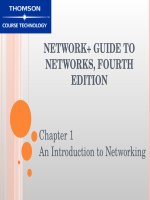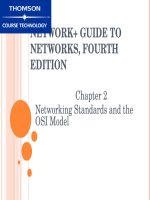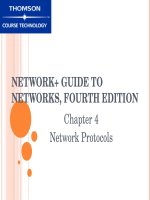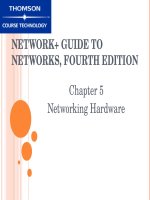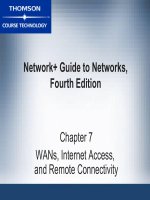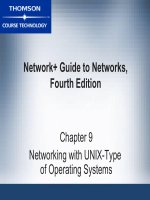Guide to network essentials 4th chapter 11
Bạn đang xem bản rút gọn của tài liệu. Xem và tải ngay bản đầy đủ của tài liệu tại đây (854.19 KB, 56 trang )
Chapter 11:
Enterprise and
Distributed Networks
Learning Objectives
Understand how modems are used in network
communications
Understand faster alternatives to modems for
network communications
Survey different types of carriers used for longhaul network communications
Explain how larger networks may be implemented
using devices such as repeaters, bridges, routers,
brouters, gateways, and switches
Guide to Networking Essentials,
2
Modems in Network Communications
Modems convert or MOdulate digital signal from
computer into analog signal to be sent on
telephone lines
DEModulate analog signal back to digital
See
Figure 11-1
May be internal or external
External
one has power supply and uses RS-232
serial interface
Include RJ-11 connectors for telephone lines
May be Hayes-compatible
Guide to Networking Essentials,
3
Modems Convert Digital Signals to Analog
and Vice Versa
Guide to Networking Essentials,
4
Modem Speed
Measured in bits per second (bps)
V-series standards from International
Telecommunications Union (ITU) define speeds
Terms bis (second) and ter (third) indicated revisions
Baud refers to number of oscillations of sound
per second
Earlier, baud and bps were interchangeable,
but today more than one bit transmits per baud
Guide to Networking Essentials,
5
Types of Modems
Two types of modems
Asynchronous
Synchronous
High-speed digital technologies use special
“modems”
DSL
modem
Cable modem
Guide to Networking Essentials,
6
Asynchronous Modems
Converts data byte into stream of ones and zeros
Stop
and start bits surround each byte, as
shown in Figure 11-2
Flow control and data coordination use 25%
of bandwidth
May use parity bit for error checking
May compress data for higher transmission
speeds
Common
method is MNP Class 5 compression
Guide to Networking Essentials,
7
Asynchronous Modems
Use Start and Stop Bits
Guide to Networking Essentials,
8
Asynchronous Modems (continued)
V.90 is current asynchronous modem standard with
connection speeds up to 56 Kbps
Typical Internet connection using V.90 does two-way
conversion, as shown in Figure 11-3
Uses pulse code modulation (PCM) to
reduce noise, as shown in Figure 11-4
Asymmetric communication uses different download and
upload speeds
Limited to 33.6 Kbps from modem to ISP
Achieves 56 Kbps from ISP to modem
Guide to Networking Essentials,
9
Modem Communications with Two
Analog-to-Digital Conversations
Guide to Networking Essentials,
10
Modem Communications
Using V.90 Standard
Guide to Networking Essentials,
11
Synchronous Modems
Use timing to determine where data begins and
ends
Use
periodic synch bits to synchronize modems
Transmit groups of bits in blocks called frames, as
shown in Figure 11-5
Faster than asynchronous modems and provide
functions such as error-checking
Guide to Networking Essentials,
12
Synchronous Modems Send
Synchronization Bits Periodically
Guide to Networking Essentials,
13
Synchronous Modems (continued)
Three synchronous protocols
Synchronous
Data Link Control (SDLC)
High-level Data Link Control (HDCL)
Binary Synchronous (bisync) Communications
Used on dedicated lease lines
Guide to Networking Essentials,
14
Digital Modems
Term not technically accurate; does not translate
from analog to digital
Usually refers to interface for Integrated
Services Digital Network (ISDN)
ISDN actually uses two adapters
Network
termination (NT) device
Terminal adapter (TA) equipment
Guide to Networking Essentials,
15
Digital Modems (continued)
Cable modems use broadband CATV cables
and a NIC with RJ-45 connector
Some
are analog, but most are digital
Maximum bandwidth is 1.5 Mbps
Use shared access media
Not limited by distance
Strong 56-bit encryption key ensures privacy
Guide to Networking Essentials,
16
Digital Modems (continued)
Digital Subscriber Line (DSL) works with
regular twisted-pair telephone line
Connections
are not shared
Guaranteed bandwidth of at least 384 Kbps
upstream and downstream
Distance limitations between user and central office
(CO), usually between 17,500 feet (3.31 miles) and
23,000 feet (4.36 miles)
Guide to Networking Essentials,
17
Digital Modems (continued)
Two varieties of DSL
Asymmetric
Digital Subscriber Line (ADSL) with
speeds up to 8 Mbps download and 1 Mbps upload
Symmetric Digital Subscriber Line (SDSL)
with equal upload and download speeds
DSL and cable modems maintain constant
connections to remote server
Guide to Networking Essentials,
18
Carriers
Three considerations affect choice of modem
and connection for remote network
communications
Throughput
Distance
Cost
Guide to Networking Essentials,
19
Carriers (continued)
Four carrier options through public switched
telephone network (PSTN):
Dial-up
ISDN
DSL
Dedicated
leased lines
Guide to Networking Essentials,
20
Carriers (continued)
Dial-up is slow, usually limited to 28.8 Kbps
New
technology allows up to 56 Kbps over
some lines, with experiments up to 115 Kbps
Cost between $18-$35
ISDN offers two options
Basic
Rate Interface (BRI) has two 64-Kbps
B-channels for voice or data and one 16-Kbps
D-channel for control; cost $50-$70
Primary Rate Interface (PRI) has 23 B-channels and
one D-channel; cost $300-$1500
Guide to Networking Essentials,
21
Carriers (continued)
DSL offers 384 Kbps at cost from $30-$60
More
expensive 1.5 Mbps upstream/downstream
connection may cost between $300-$600
Dedicated leased lines offer higher speeds
Between
56 Kbps and 45 Mbps
Most expensive option
Guide to Networking Essentials,
22
Remote Access Networking
Windows 2000/2003 uses Routing and Remote
Access Service (RRAS)
Includes
local-area routing services
See Figure 11-6
Serves up to 256 remote clients
Supports virtual private network (VPN)
connections over the Internet
Guide to Networking Essentials,
23
Windows 2000/2003 RRAS
Guide to Networking Essentials,
24
Remote Access Networking (continued)
Windows XP, 2000, NT, ME, and 9x include Dialup Networking (DUN) software for remote
access connections
Two protocols for remote access
Serial
Line Internet Protocol (SLIP)
Point-to-Point Protocol (PPP)
Guide to Networking Essentials,
25
